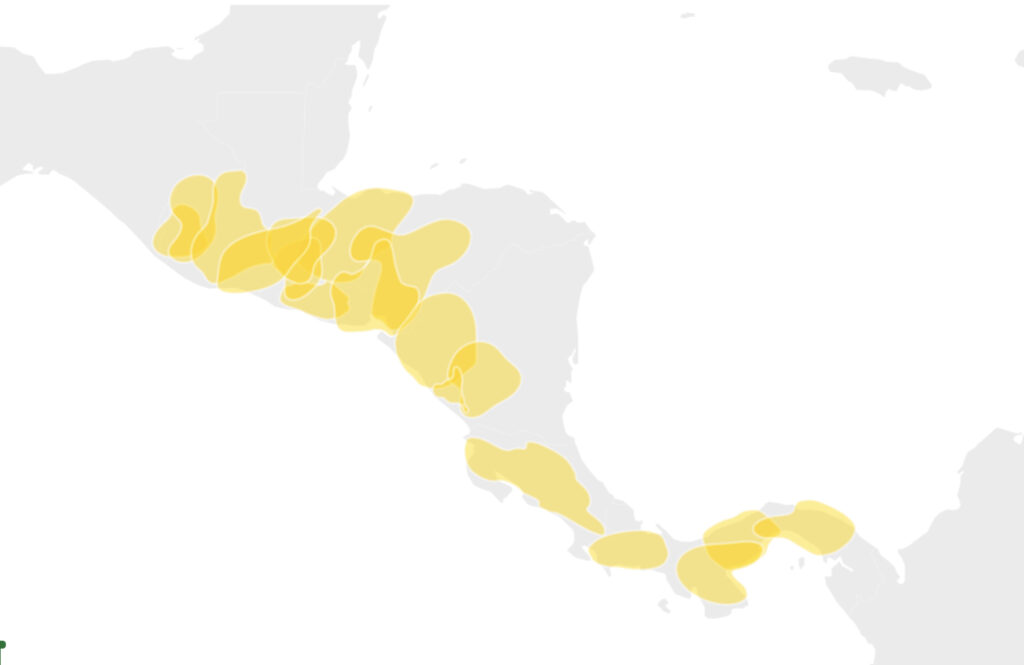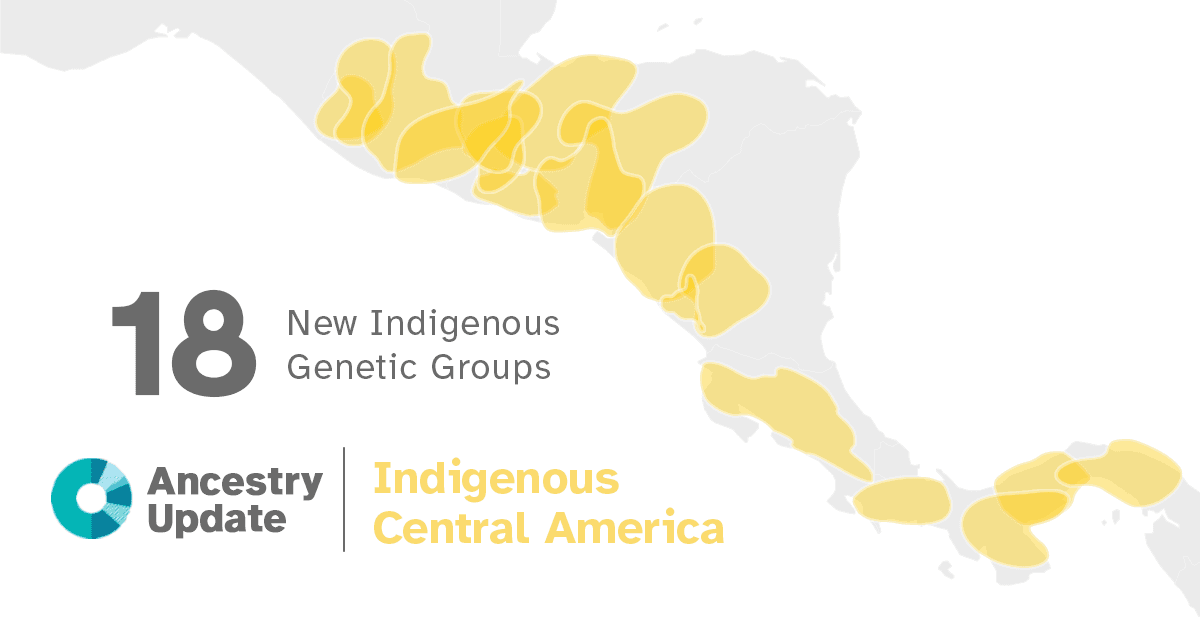23andMe has added finer detail for customers whose roots trace back to Indigenous American ancestors. There are 18 regions in Central America, from Guatemala in the north to Panama in the south.
The update is part of our continuing work to improve 23andMe’s Ancestry reports and features. Recently, 23andMe added new details for people with Indigenous Mexican Ancestry and previously updated reports on North American Indigenous ancestry and Indigenous Caribbean ancestry. This latest update allows customers with ancestry from one of these Central American indigenous Genetic Groups to see their connections genetically and geographically.
The updates help highlight the importance of Indigenous groups and culture within the region, where people of Indigenous ancestry often make up a sizable proportion of the total population. Among the countries in the region, Guatemala has the highest percentage of Indigenous people.
Indigenous Populations of Central America
Central America is at a crossroads between Mesoamerican, Chibchan-speaking, and Andean cultural and linguistic spheres.
Long before colonization, Indigenous societies like the Maya in Guatemala, southern Mexico, northern Honduras, and the Nahua in Mexico and El Salvador built thriving and sophisticated communities dating back many centuries. However, dozens of other Indigenous populations also thrived in different geographic areas of the region with their own distinct languages and cultures, such as the people of the Coclé culture in what is now Panama or the Lenca people in Honduras and El Salvador.
The ruins of Copán in Honduras offer a glimpse of the sophistication of the Mayan people dating back to pre-Columbian times.
While the region’s independence from Spain in 1821 allowed for more regional autonomy and ended the forced labor of Indigenous people, it did not improve their lives. New governments did not respect Indigenous communal land rights, which often left them in more extreme poverty. The lingering inequities from that history can be seen today within these nations, as detailed by the World Bank’s report on Indigenous Latin America.
Ancestry Composition update
23andMe’s Ancestry Composition report is a living analysis that improves as we add new reference data. Underlying our Ancestry reports are powerful algorithms and analytical tools developed by 23andMe population geneticists and engineers to offer our customers more insights into their ancestral origins.
Over the last few years, we’ve updated results to allow our customers to see more detail about their connections to specific geographic regions that correspond to Indigenous populations.
While 23andMe customers may already see evidence of recent ancestry within the nations of Central America, this update connects individuals to more specific Genetic Groups, potentially offering more details about their ancestral origins. The Genetic Groups that are part of this update are also more reflective of the distinct regional populations and customers’ ancestry.
Regions in Central America covered in this update
23andMe’s new update for Indigenous Central American ancestry looks at 18 different areas within six nations.
The new Indigenous Central American Genetic Groups correspond to shared Indigenous American ancestry within these regions. For instance, the Northwestern Guatemalan Highlands includes people who speak Mayan languages, including Akateko, Jakalteko, Q’anjob’al, K’iche’ (Qatzijob al), and Q’eqchi’. In the south, the Coclé and West Central Panama region was part of the archaeological cultural area known as Gran Coclé, which is home to the Coclé culture.
Below are the lists of Genetic Groups 23andMe has added as part of this update.

List of Genetic Groups
- Central Guatemalan Highlands — This region is home to the Maya ruins of Iximche? — the former capital of the Kaqchikel Kingdom — and Mixco Viejo, the former capital of the Chajoma Kingdom.
- Motagua River Valley and the Eastern Guatemalan Highlands — Guatemala’s Motagua River Valley is a source of green jade, a rare mineral used by Mesoamerican civilizations to create figurines, ornaments, masks, and other treasures for rituals or to reflect their owners’ high status.
- Western Guatemalan Highlands — This region boasts the restored ruins of Zaculeu, the capital city of the ancient Mam Kingdom near the modern-day city of Huehuetenango. Eventually conquered by the neighboring K’iche’ kingdom of Q’umarkaj, Zaculeu was continuously occupied for over a millennium until its abandonment in the 16th century.
- Northwestern Guatemalan Highlands — Many people in this Genetic Group speak Mayan languages of central and western Guatemala, including Akateko, Jakalteko, Q’anjob’al, K’iche’ (Qatzijob?al), and Q’eqchi’.
- Ch’orti’ of Guatemala and Honduras — This region is home to the ruins of the capital city of the ancient Maya Kingdom of Copán, which flourished between the 5th and 9th centuries.
- Goascorán River Basin and Comayagua Valley —This region was once the heartland of the Lenca people, though today most Lenca live in western Honduras. The ruins of two important commercial centers for the ancient Lenca Empire are also in this region: Quelepa in what is now eastern El Salvador and Yarumela in central Honduras.
- Central Sierra Madres—This region was once home to the southernmost Maya sites including Tazumal, but much of the region later fell under the influence of Cuzcatlan, a powerful Nahua confederation that flourished between the 13th and 16th centuries.
- Western Honduran Highlands — Once home to a number of Maya, Lenca, and Jicaque (Tolupan) settlements, this region was a crossroads between the Mesoamerican and Chibchan-speaking worlds.
- Central Honduran Highlands — This region includes the Yarumela archaeological site — the ruins of an important commercial center for the ancient Lenca Empire near what is now the capital city of Honduras: Tegucigalpa.
- Central American Volcanic Cordillera — El Salvador —This region was once part of Cuzcatlan (Kuskatan), a powerful Nahua confederation that flourished between the 13th and 16th centuries. Some people in this Genetic Group say their recent ancestors spoke Nawat (Nahuat).
- Pacific Lowlands of Western Panama — Historically, this region was part of the territory of the Ngäbe people, which extended across much of western Panama. Today, most Ngäbe live in the semi-autonomous Ngäbe-Buglé Comarca, and many still speak Ngäbere, a Chibchan language.
- Guna Yala and East Central Panama — Some people in this Genetic Group speak Guna (Kuna) — a Chibchan language spoken by the Guna people of Panama and Colombia. Today, most Guna people live on the San Blas islands off the coast of the semi-autonomous Guna Yala Comarca.
- Coclé and West Central Panama —This region was part of the archaeological cultural area known as Gran Coclé, defined by the distinctive pottery and striking artifacts made by people of the Coclé culture, primarily between 500 – 1000 C.E.
- Coclé and the Azuero Peninsula of Panama —This region was part of the archaeological cultural area known as Gran Coclé, defined by the distinctive pottery and striking artifacts made by people of the Coclé culture, primarily between 500 – 1000 C.E.
- Central Valley of Costa Rica — While relatively few people in Costa Rica identify as Indigenous today, there are still a number of Indigenous Peoples in the country including the Cabécar, Bribri, and Teribe (Térraba), among others.
- West Central Nicaragua — Northeast Cocibolca — Historically, parts of this region were home to the Matagalpa (Cacaopera) and Chorotega peoples.
- Northern Nicaraguan Highlands and Los Maribios —This region was once home to the Matagalpa (Cacaopera) of the central highlands, the Chorotega of western Nicaragua, and the Xiu (Subtiaba) of the country’s northern Pacific coastal region. Some people in this Genetic Group identify as Matagalpa (Cacaopera), though others identify as Miskito.
- West Nicaragua — Xolotlán and Cocibolca — Before Spanish colonization, this region was home to the Nicarao, a Nahuat-speaking people after whom the modern country of Nicaragua was named.
More on the update
About 1 percent of our customers, who have tested on our latest genotyping chip, will receive a match to one or more of the Genetic Groups listed. Some of the common clusters will connect customers to Northern Nicaraguan Highlands and Los Maribios, the Central Valley of Costa Rica, Coclé and West Central Panama, the Western Honduran Highlands, Central American Volcanic Cordillera in El Salvador, and the Western Guatemalan Highlands.
Find out more
23andMe customers see their Ancestry Composition.
Not yet a customer? Find out more about 23andMe’s Ancestry Service and other services.




